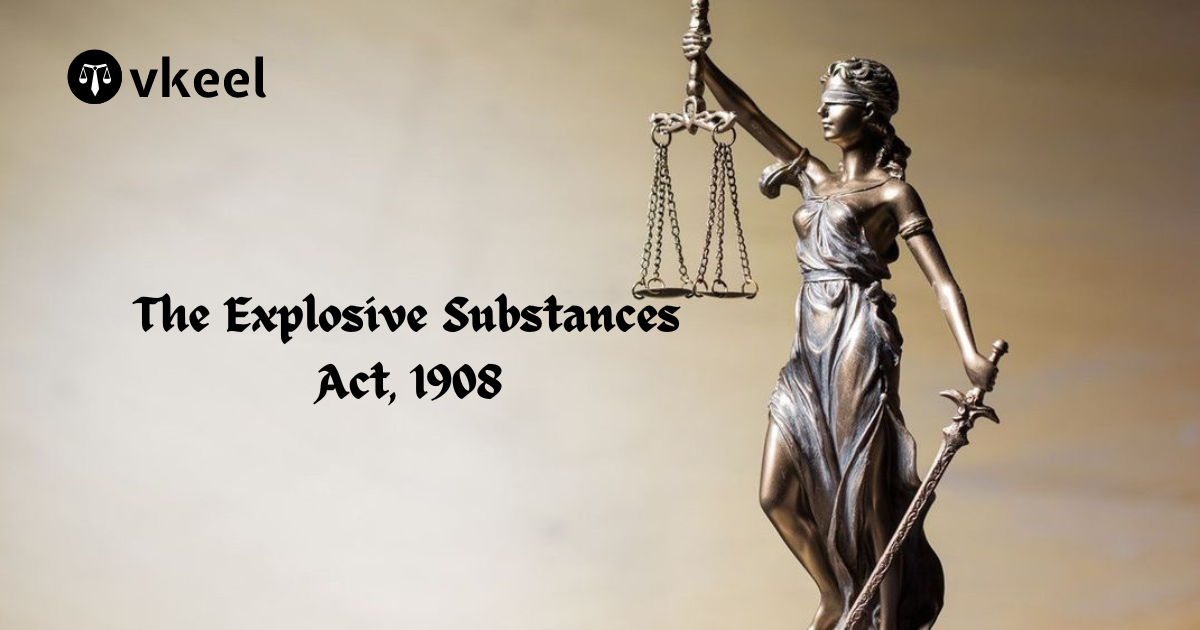The Explosive Substances Act, 1908
By Himanshu Kumar
Table of Contents
Introduction
The Explosive Substances Act, 1908, is a pivotal piece of legislation in India that governs the regulation and control of explosive substances. This Act was enacted during the British colonial period with the primary aim of preventing the unlawful and dangerous use of explosive materials, which were increasingly being used in acts of terrorism and sabotage during the early 20th century. Over the years, this Act has been amended and interpreted by various courts, making it a significant law in the context of public safety and national security.
Historical Context and Need for the Act
The early 1900s were a period of political unrest in India, with increasing activities by revolutionary groups seeking to overthrow British rule. The use of explosives in acts of violence against the colonial government, such as bombings and assassinations, was on the rise. The British government, recognizing the threat posed by such activities, introduced the Explosive Substances Act, 1908, to curb the unauthorized manufacture, possession, and use of explosives.
The Act was modeled after similar laws in the United Kingdom, such as the Explosives Act, 1875, and the Explosive Substances Act, 1883, which aimed to control the use of explosive materials and protect public safety.
Key Provisions of the Explosive Substances Act, 1908
The Explosive Substances Act, 1908, consists of 10 sections that outline the legal framework for the control and regulation of explosive substances in India. Some of the key provisions include:
- Section 3: Punishment for Causing Explosion Likely to Endanger Life or Property
This section prescribes severe penalties for any person who causes an explosion that is likely to endanger life or cause serious damage to property. The punishment includes imprisonment for life or imprisonment for a term that may extend to ten years, along with a fine. - Section 4: Punishment for Attempt to Cause Explosion, or for Making or Keeping Explosive with Intent to Endanger Life or Property
Under this section, any person who attempts to cause an explosion or makes or possesses any explosive substance with the intent to endanger life or property is liable to imprisonment for life or imprisonment for a term that may extend to ten years, along with a fine. - Section 5: Punishment for Making or Possessing Explosive under Suspicious Circumstances
This section penalizes any person found making or possessing explosive substances under suspicious circumstances. The punishment includes imprisonment for a term that may extend to seven years, along with a fine. - Section 6: Punishment of Abettors
The Act also covers the punishment for abettors, prescribing that anyone who abets the commission of an offense under this Act shall be liable to the same punishment as the person committing the offense. - Section 7: Forfeiture of Property
The Act provides for the forfeiture of any explosive substance involved in the commission of an offense and any tools, machinery, or materials used in the manufacture of such explosives.
Amendments to the Act
Over the years, the Explosive Substances Act, 1908, has undergone several amendments to address the evolving nature of threats posed by the misuse of explosives. Some of the notable amendments include:
- The Criminal Law Amendment Act, 1932
This amendment introduced stricter penalties for offenses under the Explosive Substances Act, 1908, and expanded the scope of the Act to include abetment, conspiracy, and attempts to commit offenses. - The Explosive Substances (Amendment) Act, 1949
After India’s independence, the Act was amended to bring it in line with the legal and constitutional framework of the newly sovereign nation. The amendment also introduced provisions to deal with the growing threat of terrorist activities in the country. - The Explosive Substances (Amendment) Act, 2001
In the wake of rising terrorism, particularly after the 1993 Mumbai bomb blasts, the Act was further amended to enhance the punishments for offenses involving explosives and to include new categories of offenses related to terrorism. - The Criminal Law (Amendment) Act, 2013
This amendment was part of a broader set of legal reforms in response to growing concerns about public safety and national security. It introduced stricter penalties for certain offenses under the Explosive Substances Act, 1908, particularly those involving terrorist activities.
Case Laws Interpreting the Act
The judiciary has played a crucial role in interpreting and enforcing the provisions of the Explosive Substances Act, 1908. Several landmark cases have clarified the scope and application of the Act, ensuring that its provisions are effectively implemented.
- Kartarey and Ors. v. State of Uttar Pradesh (1976)
In this case, the Supreme Court of India dealt with the issue of possession of explosive substances. The accused were found in possession of a substantial quantity of explosives without any lawful authority. The court held that mere possession of explosives under suspicious circumstances is sufficient to attract the provisions of the Act, and it is not necessary for the prosecution to prove the intent to use the explosives. - State of Maharashtra v. Mohd. Yakub and Ors. (1980)
This case involved the unlawful possession of explosives with the intent to cause harm. The Supreme Court held that the intent to endanger life or property is a crucial element that the prosecution must establish to secure a conviction under Sections 3 and 4 of the Act. The court emphasized the need for strict proof of intent to distinguish between lawful and unlawful possession of explosives. - Ram Narain v. State of Uttar Pradesh (1973)
The Supreme Court in this case dealt with the issue of abetment under the Explosive Substances Act, 1908. The court held that mere knowledge of the existence of explosive substances and failure to report the same to authorities could amount to abetment, attracting the penalties under the Act. This case highlighted the importance of vigilance and prompt reporting in preventing the misuse of explosives. - Devender Pal Singh Bhullar v. State (NCT of Delhi) (2013)
This case involved a terrorist act in which explosives were used to carry out a bombing. The Supreme Court upheld the conviction of the accused under the Explosive Substances Act, 1908, along with other anti-terrorism laws. The court emphasized the need for stringent enforcement of the Act to combat the growing threat of terrorism. - State (NCT of Delhi) v. Navjot Sandhu (2005)
Commonly known as the Parliament attack case, this case involved the use of explosives in a terrorist attack on the Indian Parliament. The Supreme Court extensively discussed the provisions of the Explosive Substances Act, 1908, in conjunction with other anti-terrorism laws. The court’s decision underscored the importance of coordinated legal responses to acts of terrorism involving explosives.
Challenges and Criticisms
Despite its significance, the Explosive Substances Act, 1908, has faced criticism and challenges over the years. Some of the key issues include:
- Outdated Provisions
Critics argue that certain provisions of the Act are outdated and do not adequately address modern threats posed by the use of advanced explosives and technologies. The Act, being over a century old, does not account for contemporary methods of manufacturing and using explosives, such as improvised explosive devices (IEDs). - Overlap with Other Laws
There is significant overlap between the Explosive Substances Act, 1908, and other laws such as the Unlawful Activities (Prevention) Act, 1967, and the Arms Act, 1959. This overlap can sometimes lead to confusion and complications in the enforcement and prosecution of offenses related to explosives. - Lack of Clarity on Intent
The requirement to prove intent to endanger life or property under Sections 3 and 4 of the Act has been a contentious issue. Courts have struggled with interpreting the standard of proof required to establish intent, leading to inconsistent judgments and challenges in securing convictions. - Enforcement Issues
The enforcement of the Act has been criticized for being inconsistent and, at times, ineffective. There have been instances where law enforcement agencies have failed to detect and prevent the illegal manufacture and use of explosives, leading to catastrophic incidents.
The Way Forward
Given the evolving nature of threats posed by the misuse of explosives, there is a need to revisit and update the Explosive Substances Act, 1908. Some potential steps that can be taken include:
- Comprehensive Review and Amendment
A comprehensive review of the Act should be undertaken to identify outdated provisions and address gaps in the legal framework. This review should consider the advancements in technology and the changing nature of threats related to explosives. - Harmonization with Other Laws
Efforts should be made to harmonize the provisions of the Explosive Substances Act, 1908, with other relevant laws, such as the Unlawful Activities (Prevention) Act and the Arms Act. This would ensure a more streamlined and effective legal framework for dealing with offenses related to explosives. - Enhanced Training and Resources for Law Enforcement
Law enforcement agencies should be provided with enhanced training and resources to effectively enforce the provisions of the Act. This includes training in detecting and neutralizing explosive devices, as well as investigating and prosecuting offenses related to explosives. - Public Awareness and Reporting
Public awareness campaigns should be conducted to educate citizens about the dangers of explosives and the importance of reporting suspicious activities. This would help in preventing the misuse of explosives and ensuring public safety.
Conclusion
The Explosive Substances Act, 1908, remains a cornerstone of India’s legal framework for combating the illegal use of explosives. While it was originally enacted during the British colonial period, its relevance has only increased in the modern era, particularly in the context of the global rise in terrorism and organized crime. The Act’s provisions, coupled with subsequent amendments and related legislation, provide a robust mechanism for ensuring public safety and national security.
However, there is a need for continuous review and reform of the Act to address emerging challenges and ensure that it remains effective in the face of evolving threats. This includes clarifying ambiguities in the law, addressing overlaps with other legislation, and ensuring that the punishments prescribed are proportionate to the offenses committed.
Ultimately, the Explosive Substances Act, 1908, serves as a powerful tool in the hands of law enforcement agencies and the judiciary, but its success depends on its judicious application and the continued commitment of the government to uphold the rule of law.
References
- The Explosive Substances Act, 1908 – Bare Act with Amendments
- Supreme Court Cases – Mohd. Khalid v. State of West Bengal, State (NCT of Delhi) v. Navjot Sandhu, State of Maharashtra v. Mohd. Ajmal Amir Kasab
- Legal Commentaries on the Explosive Substances Act, 1908
- Human Rights Reports – Criticisms of the Explosive Substances Act, 1908
Disclaimer:
The information provided in the article is for general informational purposes only, and is not intended to constitute legal advice or to be relied upon as a substitute for legal advice. Furthermore, any information contained in the article is not guaranteed to be current, complete or accurate. If you require legal advice or representation, you should contact an attorney or law firm directly. We are not responsible for any damages resulting from any reliance on the content of this website.






